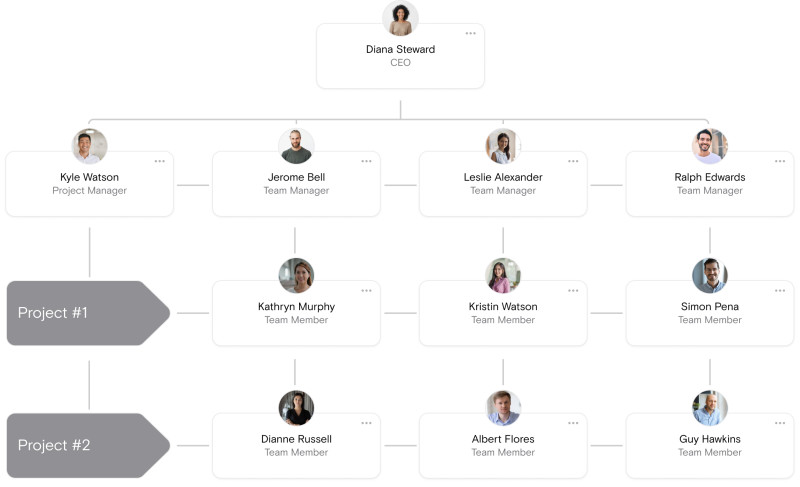- Iterate
- Organizational Structure
- Types of Organizational Structures
Table of contents
Make sense of your organization by defining an organizational structure. Learn about the 3 main types of org structures and the advantages and disadvantages of each.

There are three main types of organizational chart structures: hierarchical, flat, and matrix. For each of these primary structures, there are different variations that reflect the specific operational needs of a company.
Visually, an organization’s structure is represented with an org chart, a diagram that shows the relationship between departments and the employees within those departments.
These org charts take the company’s structure a step further and identify what jobs people do, and can sometimes tell you their responsibilities, and how decisions are made within an organization.
Knowing your organization’s structure, and creating an org chart, helps to define how information moves between the different functions of the business, improving efficiency and providing clarity about who does what job.
Hierarchical Org Structure

The hierarchical org structure is what most people imagine when they think of an organization. It is represented by the traditional org chart structure, as it is the oldest and most commonly used. With its pyramid-like shape, the chart starts at the top (usually with the CEO), with authority and accountability flowing directly down to each different department-level manager and their employees.
Hierarchical organizations have multiple levels with middle managers linking one level to the next. Employees usually only report to one manager to reduce confusion and to allow for closer monitoring and better employee performance management.
Advantages
- Easy to understand roles, responsibilities, and who the decision-makers are
- Communication flows faster with defined roles and responsibilities
- Greater accountability with decision-makers identified
- Employees know where to go with specific questions
Disadvantages
- Communication flows from the top to the bottom, which can impede innovation
- Decision-making can be slow
- Multiple management layers increase operating costs
There are two different types of hierarchical structures, functional and divisional.
-
Functional Org Structure A functional organization is the most common type of hierarchical structure. Employees are grouped according to their specific skills and job functions into departments that operate independently from the company’s other departments. For example, a marketing team might have a VP, senior manager, assistant manager, and different staff-level roles with each layer reporting to the manager above them.
-
Divisional Org Structure A divisional structure enables enterprise-sized companies to separate large sections of their business into independent divisions typically around product, market, or geographical groups. These divisions then operate as self-autonomous companies within the larger corporation with all the resources—sales, marketing, accounting, etc.—needed to support it. For example, McDonalds corporate structure is represented by a divisional org chart based on geographical areas.
Companies with a wide variation in products and services or geographic regions most commonly use the divisional structure because it gives each division greater flexibility to operate autonomously.
Flat/Horizontal Organizational Structure

Like a single-floor open office, a flat organization puts employees closer to company leadership. It also eliminates the layers of middle management providing very little hierarchy. Though there is usually a leader, most other positions are seen as equal and arranged horizontally within an org chart. In these types of horizontal organizational structures, it is more likely that all employees are empowered to make their own decisions. For example, in some companies, employees might choose the projects they want to work on.
A flat organizational structure is often used by small businesses and early-stage startups where employees wear multiple hats, work closely together and can be managed by one person. Tech-startup companies Treehouse and Buffer have flat organisational structures.
Advantages
- Empowers employees with greater autonomy
- Increases the speed of adopting new ideas
- Encourages open employee communication and feedback
- Decision making is easier and faster
Disadvantages
- Not easily scalable; difficult for large companies to adopt
- Harder to maintain accountability, especially as a team grows
- Employees lack specific bosses to report to
- Encourages generalists rather specialists increasing employee workload
Network Org Structure A network org structure is a type of flat organizational structure. In this system, companies combine resources to produce a service or product. For example, a clothing brand outsources production to Vietnam manufacturers, customer service to call centers in the Philippines, and distribution to Japan. Under this structure, managers within the network organization control both internal and external resources such as off-site offices, vendors, subcontractors, and outsourced employees. H&M is an example of a company that uses this type of structure.
Matrix Organizational Structure

A matrix organizational structure sets up reporting relationships as a grid in an org chart and uses a dual chain of command for employees. One manager handles an employee’s functional activities with a vertical flow of authority. The other—typically a project or group manager—also manages that employee but the flow of authority is horizontal. This second relationship may be temporary as projects are completed and new ones are started under different managers. Starbucks is a company that is well known for its use of the matrix organizational structure.
Advantages
- More open communication and knowledge sharing
- Increases employee skills and experiences
- Managers use the right people for each project
Disadvantages
- More managers increase overall costs
- Can create power struggles between functional managers and project managers
- Reduced speed in decision making with multiple managers
Not surprisingly, the most common uses of matrix org structures are team and project-based.
Team & Project-Based Org Structure
This structure groups employees with specific and usually complementary skills into small teams working towards a common goal. Above the team or project level, the organizational structure is hierarchical. Typically teams share responsibilities, are time-limited and are empowered to make their own decisions. This structure changes often as teams complete projects. NIIT, an Indian multinational education management company, represents its company structure using a Team & Project-Based Org Chart.
Visualizing Your Organization’s Structure
There are many types of organizational structures and, even if you start with one type of structure, the way your team interacts and works together may change over time. To make the most sense of your organization’s structure, and to help those on your team understand how everyone can best work together, use an organizational chart to visualize your team’s structure.
You can simply sketch it out on a piece of paper to start, but using org chart software will allow you to turn your team’s working structure into something that is visual and interactive. Or, join your team on The Org and start adding to your companies org chart.


The ORG helps
you hire great
candidates
Free to use – try today
